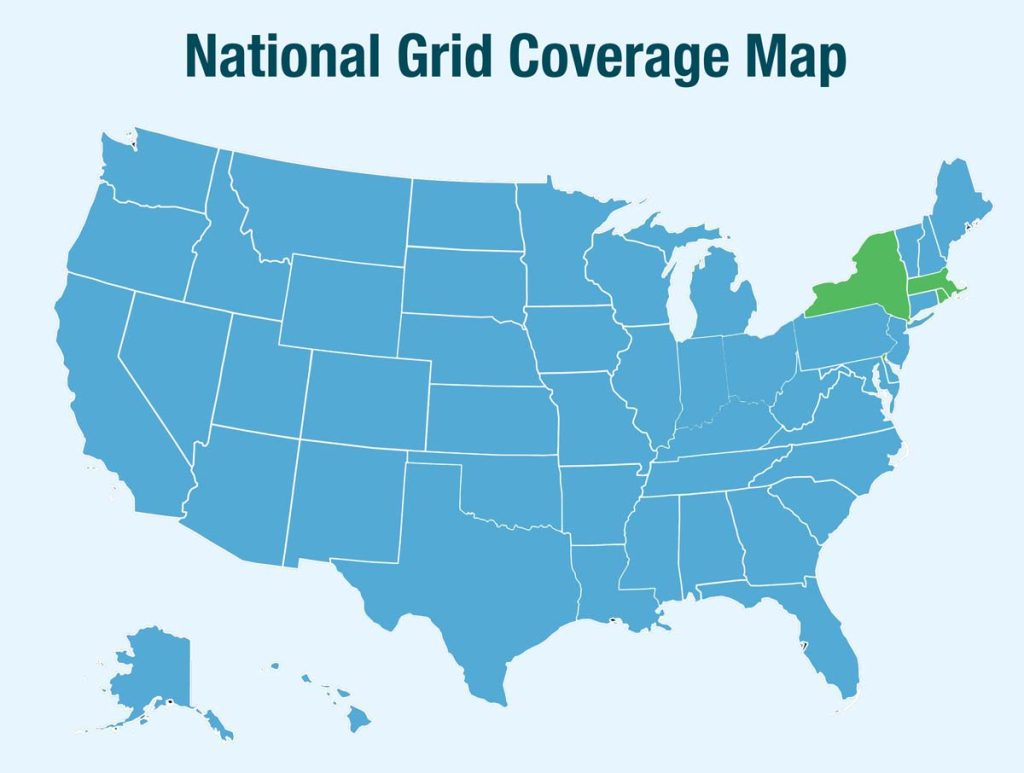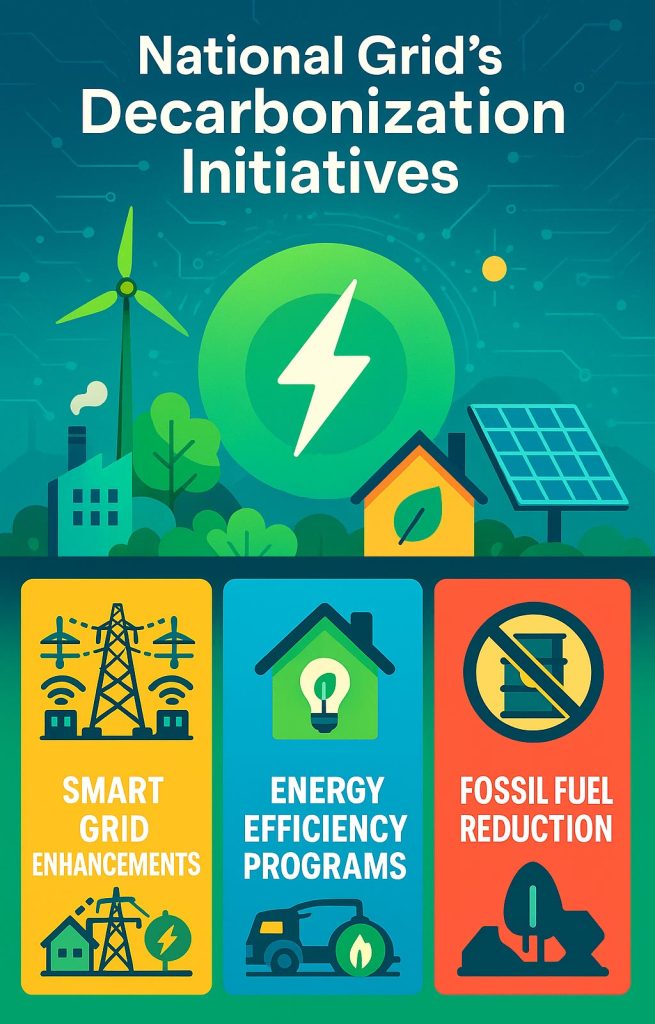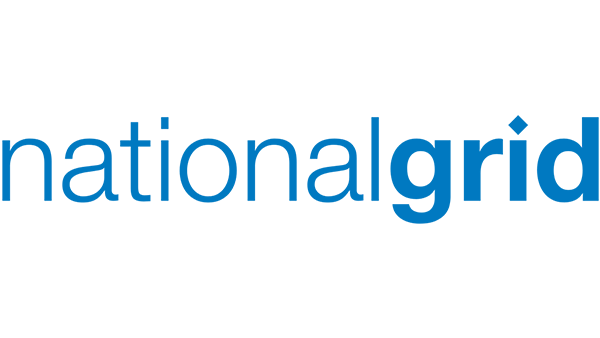- Operates in 3 states, New York, Massachusetts, and Rhode Island, with slightly different energy mixes in each
- Delivers both electricity and natural gas
- Manages over 9,000 miles of transmission lines and serves over 20 million customers
- Employs thousands of local workers for maintenance and emergencies
About National Grid
National Grid is one of the largest investor-owned energy companies in the northeastern United States. The company serves more than twenty million people across New York, Massachusetts, and Rhode Island and plays a crucial role in maintaining safe, reliable, and affordable energy service. While its parent company is headquartered in the United Kingdom, National Grid US operates independently within American regulations and focuses on electricity and natural gas delivery.
In the United States, National Grid primarily functions as a transmission and distribution utility (TDU) responsible for maintaining the infrastructure that delivers power and gas to homes and businesses. That means they manage poles, wires, substations, and pipelines rather than selling the electricity itself in competitive markets. In states that allow energy choice, customers can select a retail supplier for their energy while National Grid continues to handle delivery, service reliability, and safety.
- Calculate Your Moving Costs
- Compare Moving Companies
- Get Multiple Quotes
- Move with Confidence
National Grid’s Coverage Area

National Grid operates mainly in Massachusetts, New York, and Rhode Island. Its electric and natural gas territories are extensive across the Northeast.
Massachusetts includes both electricity and natural gas service in major cities and towns such as Boston, Worcester, Lowell, Lynn, and Quincy.
New York is divided into multiple regions. The Metro area includes Brooklyn, Queens, and Staten Island, where National Grid provides natural gas service. Long Island and the Rockaways also fall under National Grid’s gas operations. Upstate New York receives both electric and gas service, covering major cities such as Buffalo, Syracuse, Albany, and Utica.
Rhode Island receives both electricity and natural gas service through National Grid’s Rhode Island division, which supports Providence and surrounding communities.
For residents living within these territories, National Grid is the designated utility that manages the physical delivery of energy. Customers in states that allow retail choice may select a competitive supplier, but National Grid will remain responsible for delivery, maintenance, and outage restoration.
Choosing a Retail Electric Provider (REP)
One of the most important choices you have as a National Grid customer is whether to use their standard service or explore alternative retail electric supplier. While National Grid will always deliver your electricity, choosing a REP allows you to select specific energy products that might better suit your needs. This gives you more control over your energy footprint and can sometimes save you money.
Why consider a REP?
- Access to 100% renewable energy plans
- Potential for lower rates than standard service
- Fixed-rate options that protect against price spikes
- Support for specific green energy projects
Comparing Retail Provider Options
Here’s a quick look at some popular choices in National Grid territories:
Constellation Energy: Constellation Energy consistently ranks as one of the top choices in Massachusetts and New York for customers served by National Grid. The company earns high marks for clear pricing, strong renewable energy options, and reliable customer service. Constellation offers both fixed-rate and renewable plans that help customers lock in predictable costs while supporting clean power generation. Their reputation for transparency and stability makes them a strong choice for homeowners who want confidence in long-term pricing.
Direct Energy: Direct Energy remains a popular supplier across the Northeast because of its straightforward plans, competitive rates, and value-added perks such as energy tracking tools and home protection services. Customers appreciate the company’s consistent billing and responsive customer support. For households that prefer simplicity and well-established reliability, Direct Energy delivers an appealing mix of price and performance.
Tomorrow Energy: Tomorrow Energy has built a loyal following among customers who want fully renewable energy. All of their electricity plans are sourced from 100 percent wind or solar power. That focus on sustainability, paired with a transparent and fixed-rate approach, makes them one of the best green suppliers available to National Grid customers. For anyone aiming to reduce their carbon footprint while maintaining stable monthly bills, Tomorrow Energy is a standout option.
CleanChoice Energy: CleanChoice Energy specializes in clean, regional renewable energy sourced primarily from wind and solar farms located in the eastern United States. Their plans emphasize traceable green energy, strong environmental accountability, and straightforward pricing. Customers often choose CleanChoice when they want to ensure that their dollars directly support renewable generation projects near their community.
Clearview Energy: Clearview Energy rounds out the top five because of its combination of competitive rates, customer-first billing practices, and flexible contract terms. The company offers both traditional and renewable plans that fit different household needs. Their online account tools make it easy to track energy use and manage billing preferences, which adds an extra level of convenience for busy families.
Not all providers are available in all areas. Make sure to search your ZIP code to find what’s availablie to you.
Things to Consider When Picking a REP
When evaluating providers, consider your priorities: Is it price stability? Environmental impact? Customer service reputation? Many customers find the right REP can offer both environmental benefits and potential savings compared to standard utility rates.
- Rate type (fixed vs. variable)
- Contract length (avoid early termination fees)
- Renewable % (if going green matters to you)
- Customer reviews (check for hidden fees)
Learn More About Choosing A Provider
Where Does National Grid’s Energy Come From?
National Grid has committed to building a fossil-free energy future in the United States by 2050 or sooner. The company’s vision includes eliminating fossil fuels from both its gas and electric systems while expanding renewable energy integration.
National Grid has connected more than three gigawatts of distributed renewable generation, primarily from solar projects, across Massachusetts, New York, and Rhode Island. That is enough clean energy to power roughly six hundred thousand homes.
Although the company is rapidly increasing its renewable portfolio, the overall energy mix across the states it serves still reflects regional realities. According to the U.S. Energy Information Administration, most electricity in the Northeast still comes from natural gas, with smaller shares from nuclear, hydro, and renewables such as wind and solar. Massachusetts, for example, relies heavily on natural gas but continues to add solar and wind capacity every year.
For customers in National Grid’s service territory, the company provides “energy disclosure labels” that show the fuel mix and emissions associated with their electricity. These reports allow consumers to make informed choices about how clean their energy is.

National Grid’s power comes from a diverse mix that changes by season and location. During windy nights, you might get more renewable energy, while hot summer days could mean more natural gas generation. The exact breakdown varies, but here’s the general picture:
Typical energy mix:
- Natural gas: 40-60%
- Nuclear: 20-30%
- Renewables (wind, solar, hydro): Growing to 15-25%
- Other sources: Making up the remainder
Renewable Energy and Conservation Efforts
National Grid has made some of the strongest public commitments to decarbonization among major U.S. utilities. The company is investing billions of dollars in upgrading transmission and distribution networks to support renewable integration, battery storage, and the growing electrification of transportation and heating.
One of its most notable milestones is the connection of more than three gigawatts of renewable distributed generation across its service areas. National Grid is also exploring renewable natural gas and hydrogen as part of a strategy to eliminate fossil fuels from its gas network.
In addition to large-scale renewable projects, National Grid runs numerous conservation and energy efficiency programs for residential and commercial customers. These include incentives for weatherization, smart home technology, and efficient building design. The company also supports community solar programs that allow renters and small-business owners to participate in clean energy without installing rooftop systems.
National Grid’s goal is to create a cleaner, more resilient energy system that supports both the environment and affordability for customers.
National Grid’s Decarbonization Initiatives
National Grid USA is actively investing in modernizing its infrastructure to support a cleaner energy future:
- Smart Grid Enhancements: Implementing advanced technologies to manage a dynamic energy supply and demand .
- Energy Efficiency Programs: Allocating funds for residential weatherization and energy-saving initiatives, especially for low-to-moderate-income households .
- Fossil Fuel Reduction: Committing to a fossil-fuel-free gas distribution network by 2050, focusing on renewable natural gas and hydrogen integration.
These efforts align with broader goals to achieve a net-zero energy system, ensuring a reliable and sustainable electricity supply for the regions served.
How to Check & Report Outages
National Grid offers multiple channels for checking the status of outages, including an interactive outage map. For example, their “Outage Central” site allows you to see known outages (by region), estimated time of restoration (ETR), and other storm-safety information.
How to report an outage
- In New York / Upstate for electric service: Use the “Report or Check an Outage” tool online, or call 1-800-867-5222.
- In Massachusetts business site: If you lose power, call 1-800-465-1212 or report online.
- Some regional messaging: Text-based alerts available: e.g., to report outages text “OUT” to 64743 (after enrolling with “REG” to 64743) in one region.
Tips and what to watch
- If you’ve lost power, before calling check breakers, check whether neighbours have power — this helps determine whether it’s a broader outage or a household issue. Some pages show a “diagnose partial power” tool.
- If you rely on life-sustaining equipment, make sure you enroll in any special protections offered. The outage pages mention “Life Sustaining Equipment” support.
- During storms, sign up for text/email alerts so you get restoration updates and safety tips.
- Even if you choose a separate supplier for your energy commodity, National Grid continues to be responsible for delivery, so they remain your call for outages, service restoration, and safety.
National Grid’s App & Digital Tools
The National Grid mobile app allows customers to manage accounts, monitor outages, receive notifications, and view billing or usage details from their smartphone. It is available for both iOS and Android devices. Their free mobile app puts control in your pocket with:
- Real-time outage maps
- Usage monitoring with daily breakdowns
- Secure bill payment options
- Energy-saving tips tailored to your usage
- Paperless billing enrollment
Saving Money with National Grid
Beyond basic service, National Grid offers numerous programs to help customers reduce energy waste and save money. Seasonal programs also exist to help income-qualified customers manage their energy costs during peak usage periods.
Rebates and incentives:
- Up to $500 for high-efficiency HVAC systems
- $50-$150 for ENERGY STAR certified appliances
- Free home energy assessments
- Smart thermostat installation discounts
Special programs:
- Budget billing to smooth out seasonal costs
- Payment assistance for qualifying households
- Free weatherization for income-eligible homes
- Electric vehicle charging incentives
- Solar panel interconnection support
Why National Grid Stands Out
National Grid combines the reliability of a century-old utility with a clear forward-looking plan for a clean energy future. The company invests heavily in grid modernization, renewable integration, and customer programs that promote efficiency and sustainability.
Its strong record of connecting renewable projects, its public commitment to a fossil-free network, and its robust rebate programs make it one of the most progressive utilities in the Northeast. For consumers, that means a company focused not only on keeping the lights on but also on preparing for the next generation of clean, affordable energy.
Making the Right Choice
As you consider your options with National Grid, remember you have more control than you might realize. Many customers find that combining National Grid’s reliable delivery with a carefully chosen retail provider gives them the best balance of service and value. With the company’s ongoing investments in cleaner energy and grid improvements, customers can expect even more options in the coming years.
If you live in NY, MA, or RI, National Grid is your default utility, but you still have choices! You can:
- Stick with their standard service (reliable but not always green)
- Switch to a REP like CleanChoice (for 100% renewables)
- Take advantage of rebates to cut costs
Their outage tools are great, and their push toward clean energy makes them a solid pick if sustainability matters to you.
FAQs About National Grid
Where can I pay my National Grid bill?
– Online (nationalgrid.com)
– Mobile app (National Grid app)
– Phone (1-800-642-4272)
– Mail (check your bill for address)
– In person (authorized payment locations)
– Autopay (for hassle-free billing)
How do I report a power outage or gas emergency?
Gas leak? If you smell gas (rotten egg odor), leave immediately and call 911 or 1-800-892-2345
What payment assistance programs are available?
– Budget Billing (even monthly payments)
– Energy Assistance Programs (LIHEAP, fuel assistance)
– Payment extensions for qualifying customers
Does National Grid offer smart meters?
How can I track my energy usage?
– View daily/hourly usage
– Get energy-saving tips
– Set up usage alerts
About the Author
David has been an integral part of some of the biggest utility sites on the internet, including InMyArea.com, HighSpeedInternet.com, BroadbandNow.com, and U.S. News. He brings over 15 years of experience writing about, compiling and analyzing utility data.


